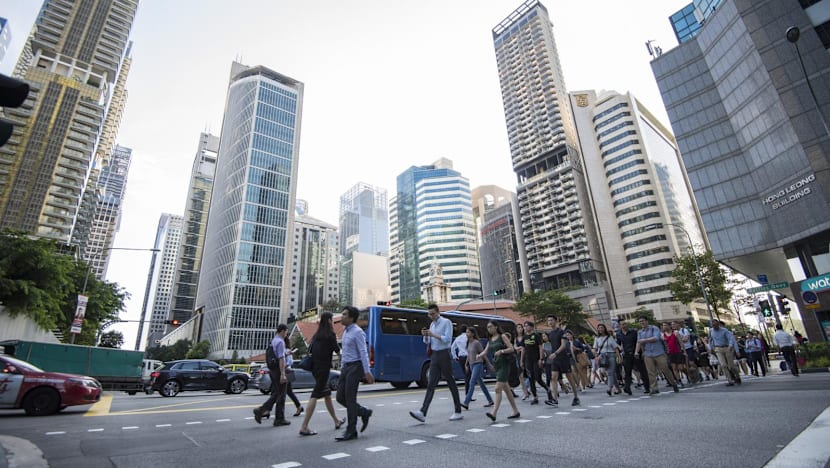Singapore's economy grew 4.3% in Q4 of 2024: MTI advance estimates
For the full year, Singapore's economy grew 4 per cent, said the Ministry of Trade and Industry.

Office workers walking on the streets of the Central Business District. (File photo: iStock)

This audio is generated by an AI tool.
SINGAPORE: Singapore's economy grew at a slower pace in the last quarter of 2024, growing 4.3 per cent compared with the same period last year, according to advance estimates released by the Ministry of Trade and Industry (MTI) on Thursday (Jan 2).
In the third quarter, the economy grew 5.4 per cent.
For the full year, however, GDP growth stood at 4 per cent for 2024, faster than the 1.1 per cent reported in 2023.
Economic growth in 2024 was above expectations, Prime Minister Lawrence Wong said in his New Year message, adding that most workers in Singapore received wage increases that outpace inflation.
In November, Singapore upgraded its economic growth forecast to around 3.5 per cent, above the range of its previous prediction.
OCBC's chief economist Selena Ling said the annual growth rate was the highest since 2021 and exceeded both official forecasts and general market expectations.
She said the growth support was broad-based and noted that first and second quarter growth was revised upwards.
"Notwithstanding the blockbuster year in 2024, the 2025 outlook is still largely obscured by external headwinds including expected Trump 2.0 tariffs, US-China strategic rivalry, and geopolitical tensions," said Ms Ling. She said OCBC is lowering its growth forecast from 2.7 per cent year-on-year to 2.2 per cent given the higher base in 2024.
Barclays economist Brian Tan said the very strong third quarter did not look like it would be sustained and that there are signs that the economy is peaking, though Singapore is entering 2025 "on a relatively strong footing".
"But still, the horizon is cloudy, and given what we know about the incoming US administration and their threats to already put tariffs in place on their trading partners, it's going to be, I think, a relatively challenging 2025 compared to 2024," he told CNA's Asia First.
He added that Singapore is an "ultra open economy" and that tariffs or global trade tensions will crimp growth in the country.
In the fourth quarter, the construction sector grew by 5.9 per cent, and the wholesale and retail trade sector, together with the transportation and storage sector, grew 5.6 per cent.
UOB associate economist Jester Koh said the strong performance in the fourth quarter was led by a sustained sequential expansion in services and strength in construction, which offset a pullback in manufacturing.
Trade-related sectors were lifted by the ongoing upturn in the electronics cycle, while financial services received a boost from higher trading volumes amid financial market volatility and increased demand for loans as central banks began cutting rates, he said.
On a quarter-on-quarter seasonally-adjusted basis, the economy expanded by 0.1 per cent, less than the 3.2 per cent reported in the third quarter.
Advance estimates are largely computed from data in the first two months of the quarter, October and November in this case. They are intended as an early indicator and may be revised later when more data is available.
Despite US trade policy affecting regional trade in 2025, JP Morgan's emerging markets Asia economist Jin Tik Ngai said broadly resilient external demand and front-loading activity may continue to support manufacturing and external sector performance in the near term.
In 2025, the bank expects Singapore's GDP growth to be 2.8 per cent given its high trade intensity and extensive supply-chain linkages to China, which is likely to be the direct target of US trade policies.
SLOWER GROWTH IN MANUFACTURING
The manufacturing sector grew 4.2 per cent in the fourth quarter compared with the previous year, down from the 11.1 per cent expansion in the third quarter.
MTI said growth in the last three months of the year was driven by an increase in output in the electronics and transport engineering clusters.
On a quarter-on-quarter seasonally adjusted basis, manufacturing contracted by 2.5 per cent after growing 12.8 per cent in the third quarter.
Mr Tan of Barclays said electronics remains a bright spot for Singapore and as the artificial intelligence narrative plays out, it should support the semiconductor cycle, which would be help manufacturing in Singapore.
The construction sector reported a 5.9 per cent growth in the fourth quarter, a faster pace than the 4.7 per cent growth in the third quarter.
The growth was driven by an increase in public sector construction output.
On a quarter-on-quarter seasonally adjusted basis, the sector grew 3.4 per cent, faster compared with the 1.6 per cent growth in the third quarter.
For services sectors, the wholesale and retail trade and transportation and storage sectors grew 5.6 per cent, compared with 5.2 per cent in the previous quarter.
"All sectors within the group, except for the retail trade sector, recorded expansions during the quarter," said MTI. Growth in the wholesale trade sector was mainly driven by the machinery, equipment and supplies and "others" segments, the ministry added.
For the transportation and storage sector, storage and other support services and air and water transport segments supported growth.
On a quarter-on-quarter seasonally adjusted basis, the wholesale and retail trade sector, together with the transportation and storage sector, shrank by 0.2 per cent. In the third quarter, it grew 0.8 per cent.
The group of sectors comprising the information and communications, finance and insurance, and professional services sectors expanded by 3.7 per cent in the fourth quarter, easing from the 4.3 per cent growth in the previous quarter.
All sectors within the group grew, driven by the IT and information services segment, the head offices and business representative segment and the strong performance of banking, fund management and activities auxiliary to financial services segments. The activities auxiliary to financial services comprised mostly payment firms.
On a quarter-on-quarter seasonally adjusted basis, this group of sectors grew 3.8 per cent, faster than the 1.5 per cent reported in the previous quarter.
All sectors in the remaining group of services sectors - accommodation and food services, real estate, administrative and support services and other services - grew in the fourth quarter. As a group, they reported 2.6 per cent growth, up from 1.4 per cent in the third quarter.
"The accommodation and arts, entertainment & recreation sectors expanded in tandem with the continued recovery in international visitor arrivals," said MTI.
On a quarter-on-quarter seasonally adjusted basis, the sectors in the group collectively grew by 0.4 per cent, compared with the 1.2 per cent expansion in the third quarter.














